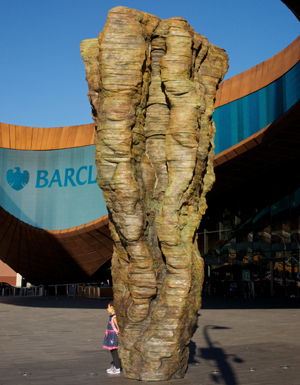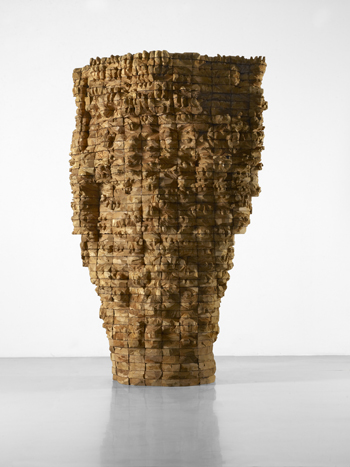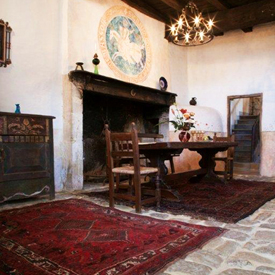
Ursula von Rydingsvard in her studio with assembled cedar components of Katul Katul (1999-02).
Photo by Jerry L. Thompson
Copyright of the Artist, Courtesy of Galerie Lelong, New York
Ursula von Rydingsvard’s abstract sculptures tower before the viewer, and yet are in no way menacing, appearing instead like gentle giants. When shown indoors, many of them resemble displaced blocks of the landscape that have found their way into the manmade environment. From afar, the viewer has the impression of seeing mountains, slabs of congealed lava, or the Earth’s entrails that have suddenly surged onto its surface. Tireless and conscientious, Ursula von Rydingsvard spends entire days at her studio in Brooklyn, on scaffolding that surrounds her huge sculptures or bent over the 4”×4” cedar beams that lie on the floor, marking the places where she and her assistants will make countless cuts with a circular saw. Dressed in black, with fingerless gloves on her hands so that she can feel the texture of the wood under her fingertips, she works in silence. The only music one can hear in her almost 5-metre high studio is the whirring of a circular saw and the tapping of a mallet on a chisel. Highly intensive and time-consuming, her sculptures evoke the labour that her parents and peasant ancestors had to perform.

Ursula von Rydingsvard
Spoon Ladle with Bent Handle, 2011
Cedar, graphite
138 x 34 x 17 inches (350.5 x 86.4 x 43.2 cm)
Copyright of the Artist, Courtesy of Galerie Lelong, New York
Ursula von Rydingsvard was born on July 26, 1942 in Deensen, in what was then Nazi Germany. Her parents were Ignacy and Kunegunda Karoliszyn, a Polish-speaking Ukrainian father who worked as a forced labourer at a farm and a Polish mother who escaped the same fate on account of her several small children. After World War II ended, Ursula, her six siblings, and her parents were moved to eight refugee camps for displaced Poles in Germany, because instead of returning to then-communist Poland, they decided to leave for America. In 1950, they arrived in Plainville, Connecticut, where they received support from the local community but still had to endure many of the hardships typically faced by immigrants. Hard work continued to be the theme of their lives.
In the German refugee camps, the future artist then known as Urszula Karoliszyn lacked toys, and instead played with wooden objects such as sticks and balls. Kitchen utensils, farm tools, and the barracks with their raw wooden floors and walls nourished her imagination. She lived very close to nature, close to the soil. She played in the meadows, in the forest, or in the ruins of bombed houses, building her first imaginary places with scattered bricks. The reminiscences of these earliest experiences are expressed in her art.
Although most of her work is abstract, some of von Rydingsvard’s sculptures clearly embody memories of her early childhood. She takes ordinary objects such as a spoon, a ladle, a shovel, or a bowl, which were present in the camp barracks that were her family’s living quarters, and transforms them into works of art. Sculpted in red cedar, oversized, they hang on the walls or sit – huge – on the floor. They act as something of a reminder of the war and the first postwar years, when the simplest object seemed extraordinary to a child.
In her artwork, von Rydingsvard draws attention to these ordinary objects, which provided her with comfort during those challenging years. Spoons and bowls were among the few symbols of stability in uncertain times, as they were things that one could literally hold onto. The images of oversized utensils and tools carved by the artist in cedar bring to mind the sparse and unembellished poetry of Tadeusz Różewicz, who lived through and fought the Nazi occupation of Poland, and especially his poem “In the Middle of Life”:
“After the end of the world
after my death
I found myself in the middle of life
I was creating myself
I was building a life
people animals landscapes
this is a table I was saying
this is a table
on the table lies bread a knife
a knife is used to cut bread
people feed on bread”
Von Rydingsvard also builds “a life, people, animals, and landscapes” in her seemingly abstract cedar figures.

Ursula von Rydingsvard
Ona, 2013
Bronze
19 feet high
Copyright of the Artist, Courtesy of Galerie Lelong, New York
Western red cedar wood has been von Rydingsvard’s primary material since 1975, but it should be mentioned that in the earliest stages of her career, during her studies in Columbia University’s MFA program, the artist created steel sculptures. Since steel seemed sterile to her and did not allow her to express herself freely, she began to use cedar, which was not only more pliable and softer but also sensual and organic. She continues to use cedar as her main sculptural material despite the fact that she has developed an allergy to it and needs to wear a heavy protective suit on her body and a respirator on her face while at work. She has also experimented with different materials for her sculptures, such as cow intestines, polyurethane resin, and, most recently, bronze. In late summer of 2013, she made a six-metre-tall bronze sculpture entitled Ona that was installed in front of Barclays Center, an arena for sports and entertainment in Brooklyn. Even in this case, the sculptor first made a full-scale cedar model for Ona, and then cast it in bronze that weighs over 5,000 kilograms. The rugged silhouette of Ona looks as if it predated the stadium by centuries, and yet it feels alive. Its undulating surface, full of crevices, resonates with vitality and energy, almost as if it were a solidified swirling funnel of wind.
Passionately engaged in all stages of her work, Ursula von Rydingsvard once regularly traveled to a mill on Vancouver Island in British Columbia to choose the wood for her sculptures. The mill workers were able to learn what she particularly liked, and today, 18-wheelers deliver cedar to her studio in Brooklyn. The studio itself resembles a lumberyard, and includes not only works in progress but also unfinished pieces from the past that may again inspire her one day.

Ursula von Rydingsvard
Bowl with Fingers, 2007-08
Cedar
64 1/2 x 40 x 37 1/2 inches (164 x 102 x 95 cm)
Copyright of the Artist, Courtesy of Galerie Lelong, New York
Each of von Rydingsvard’s sculptures begins with an image in her head. Instead of then drawing the image on paper, Ursula uses a piece of chalk to outline the rough shape of the sculpture that she is about to start working on directly on the floor. She lets her emotions guide her through the process, and does not always know where she is going, like a writer beginning to write her story who is later surprised by its final shape. Typically, her sculptures contain hundreds, if not thousands, of pieces of cedar beams that are carved, glued together, and stacked on top of each other. In a way, they resemble giant interlocking wooden puzzles. Aided by her four assistants, von Rydingsvard softens the hard edges of the wooden pieces with a circular saw and rubs powdered graphite on the surfaces of her sculptures in order to defamiliarize the wood, render it less homey, and blot out the traces of nostalgia that are often associated with it. Her works are characterized by the interplay between their massive dimensions and the intricate details on their surfaces, which one notices upon close examination. Incisions in them hint at written text, but also at bruises.
Ursula von Rydingsvard’s pieces are emotionally charged. She admires the work of Giotto and Giacometti, and particularly the psychological tension and emotional power of their figures. Some of her works seem to be visualizations of her emotions; sometimes anger, sometimes grief. These multifaceted works can have different meanings for each viewer, just as good poems can. Some of her sculptures suggest a shelter or refuge, like the barracks were for her family during and after the war. They are cocoons in which one can hide. Some of them are playful, like the translucent and light Damski Czepek, which resembles a cave, while others evoke sepulchers in a cemetery. There are also sculptures whose forms suggest mountains, such as her early piece For Weston, while some even directly make this connection in their titles, like Seven Mountains and Lace Mountains.

Ursula von Rydingsvard
Droga, 2009
Cedar, graphite
54 x 115 x 219 inches (137.2 x 292 x 556.3 cm)
Copyright of the Artist, Courtesy of Galerie Lelong, New York
One of von Rydingsvard’s favorite texts, which she has read numerous times, is Rilke’s Duino Elegies. Just as Rilke ponders humanity’s place in the universe and our relationship with nature as well as the conflicting and extreme emotions that life inspires, von Rydingsvard’s sculptures seem to reflect on these things. Her cedar mountains conjure Rilke’s “mountains of primal grief.” Her sculptures are her Elegies.
Ursula von Rydingsvard’s artwork suggests the presence of both luminosity and grief, resilience and frailty, lightness and strength, and a desire to move up while being firmly rooted in the earth. Her sculptures often feel alive, as if they were breathing and moving. Droga, for instance, is both a landscape and a body. It evokes a road and a tunnel, a strange reptile at rest that is about to slither forward, or the limb of a prehistoric animal.

Ursula von Rydingsvard
Collar with Dots, 2008
Cedar, pigment
115 x 137 x 7 1/2 inches (292.1 x 348 x 19 cm)
Copyright of the Artist, Courtesy of Galerie Lelong, New York
If, on one hand, von Rydingsvard can carve wood to resemble the fractured bedrock that outcrops the surface of the earth, she can also craft cedar that appears to be a delicate fabric. Like an alchemist, von Rydingsvard is capable of transfiguring and changing the nature of the cedar pieces that she works with, transforming their woodiness into fabric or lace-like textures that look as if they could be wearable, if not for their size. One sees this quality in pieces such as the three-metre wide Collar with Dots, which is made of cedar but seems like handmade lace. It is hard to imagine that the needlework-like quality of this and other pieces is the result of cuts made with a circular saw.
While very attached to the city of artists and immigrants that is New York, and to its museums, galleries, and flea markets, von Rydingsvard is also inspired by the indigenous art of Mexico, Japan, and Africa, as well as by her Polish heritage. Many of her works, although created in America, have Polish titles such as Luba, Ogromna, Droga, Ona, Zygmunt, Moja, Elegantka, Dorotka, Ślepa Gienia, Damski Czepek, Maglownica, and Czara z Bąbelkami. The titles, so foreign to her public in the English-speaking world, not only render the meaning of her sculptures more enigmatic but also underscore the importance of her roots. She has returned to Poland many times, starting in 1985, and held a solo exhibition at the Contemporary Art Center at the Zamek Ujazdowski in Warsaw in 1992. During her trips to Poland, she also visited villages where many old-fashioned wooden houses remained, although these are increasingly rare today. The wooden buildings reminded her of her early childhood and of the feeling of being sheltered within the wooden barracks, despite the rawness and poverty also associated with them.
Von Rydingsvard has received many accolades and awards, including a Guggenheim Fellowship and grants from the National Endowment for the Arts. Her work is part of the permanent collections of major American museums, including the Museum of Modern Art, the Metropolitan Museum of Art, and the Whitney Museum of American Art in New York. In April, Ursula von Rydingsvard will be one of the recipients of the 2014 Lifetime Achievement Award from the International Sculpture Center. A retrospective exhibition of her work will also be held at Yorkshire Sculpture Park in England, which is the biggest exhibition that she has ever had, containing over 40 pieces, including a new bronze sculpture entitled Bowl with Lace.
Almost 40 years ago, Ursula von Rydingsvard was struggling in New York as a single mother with a child. She lived frugally, held several teaching jobs, and walked instead of taking the subway. She began to create at the margins of Minimalism, inspired by others but following no one. She only wanted to be an artist, and was ready to work her hardest to achieve it.
CR




Just saw this link on the BBC; Ursula von Rydingsvard’s work will be on display at the Yorkshire Sculpture Park in Wakefield, UK from Apr 05, 2014 through Jan 04, 2015. Looks fantastic! http://www.bbc.com/culture/event/20140212-ursula-von-rydingsvard